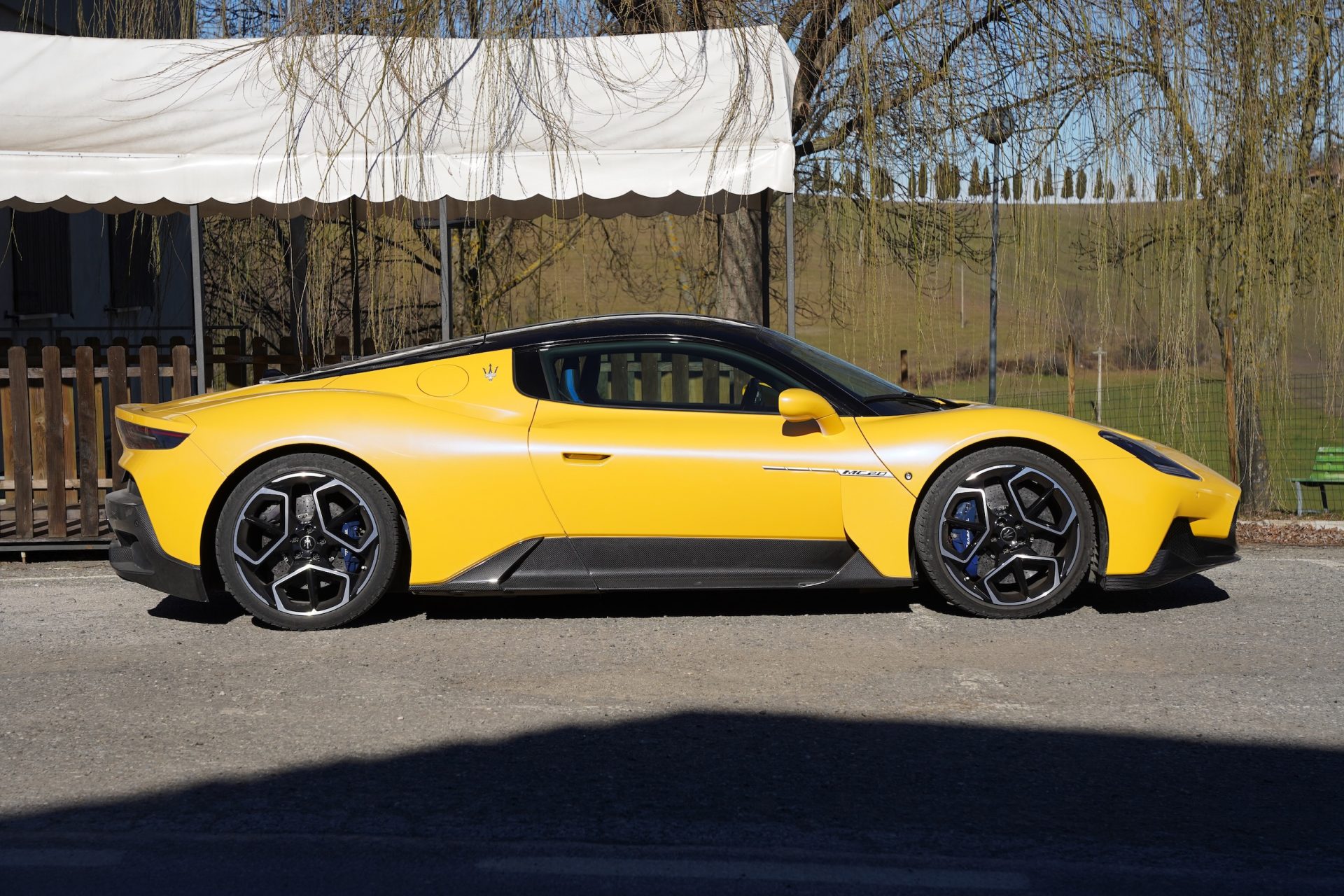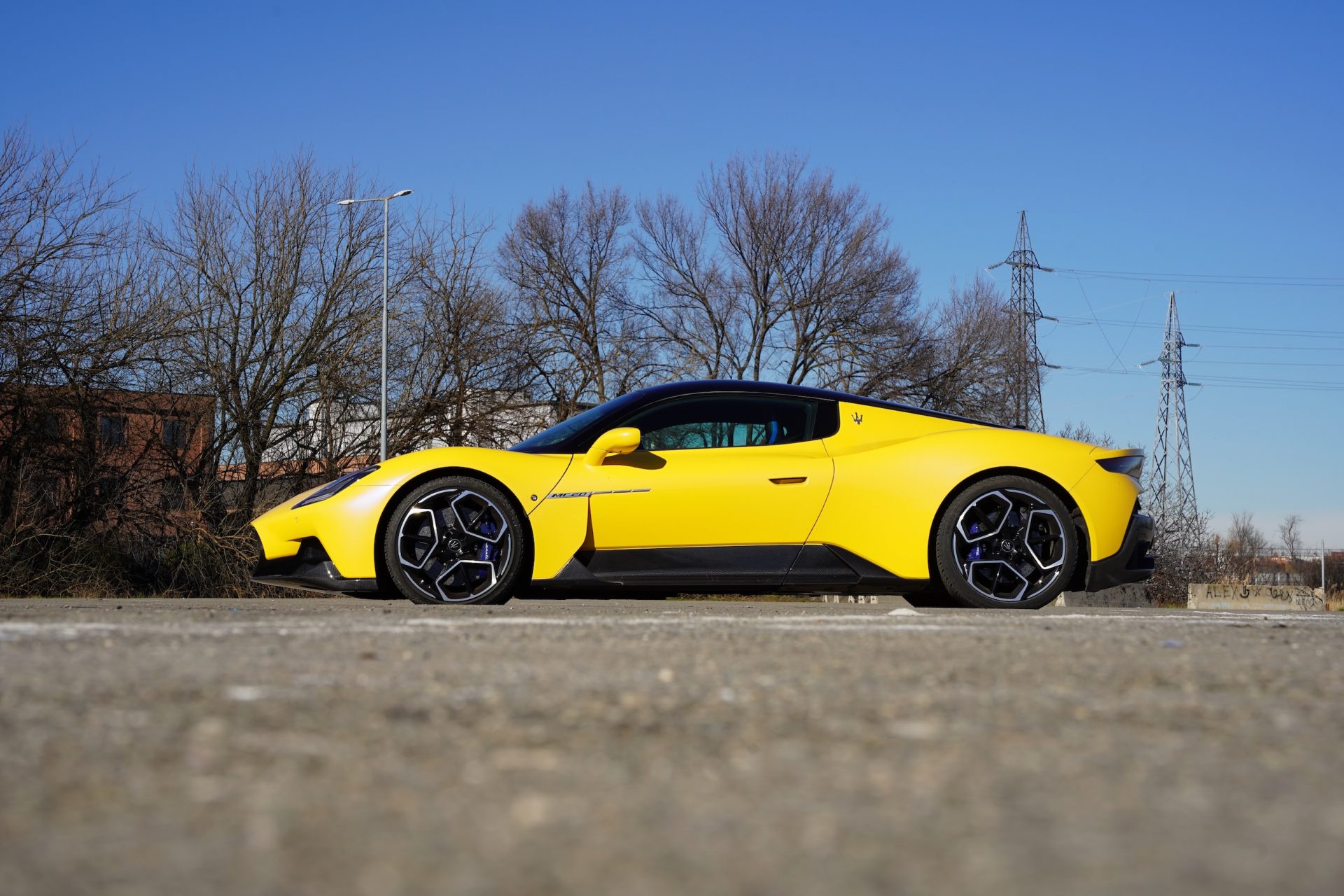The very fine blade
And then they come up with a thing like this. Out of nowhere, so to speak. Well, exactly 50 years ago Maserati already built mid-engined sports cars, the Bora and the Merak, but first of all that was a long time ago and secondly it was anything but a success. Yes, with the Alfa Romeo 4C the Modenese have been able to gain experience in recent years, especially with the carbon monocoque, but that was commissioned work, not their own product. Now, with the MC20, a completely new era is dawning. And on many different levels.

There in the hills south of Modena, the roads are narrow. Some of them are very curvy, with wonderful serpentines winding their way up the mountain. And consequently down again. The traffic is moderate, as is the quality of the roads. You could easily hide a Maserati Levante in some of the potholes, and the road breaks are even worse, sometimes they are like steps. Just moving a worn-out Fiat Ritmo Diesel along these lanes at a reasonable speed is painful to the core.

But these miserable roads south of Modena (and also Bologna, where Lamborghini tests) are also the explanation for a phenomenon: the suppleness. The light-footedness that is characteristic of Italian sports cars. While there are nice curves around Weissach, the road surface there is as soft as a baby’s nappy. Even a cigarette butt (filterless) that happens to fall out of the car is a rougher obstacle to drive around. Potholes: never. Transverse joints: extremely rare. And that’s why a Porsche is the proverbial plank. And the Maserati MC20 is buttery smooth in comparison. Of course, this is all relative, a compact SUV from the north of Germany or the centre of France wobbles and wobbles and does quite differently. With the new Maserati MC20 it’s just somehow: perfect. It doesn’t wobble at all, not even at very, very high cornering speeds – and yet it’s comfortable. Supple, as already mentioned, just that: light-footed.

Which is partly due to the weight. Carbon monocoque, we already mentioned, is supplied by Dallara, where the same is put into the oven for several manufacturers, including the Bugatti Chiron. McLaren also uses aluminium subframes, and the English are giving the competition from Maranello, Sant’Agata and Weissach a run for their money, partly because of the weight. The official weight of the MC20 is 1470 kilos, which is lighter than the lightest 911. But we know from other Italian manufacturers how they measure such things: they leave out the scales, prefer to measure it by pi x thumb – and then round it off. Whatever the DIN figure says: the new Maserati is definitely not obese.

Everything about the Maserati MC20 is new, in fact, it comes out of nowhere. It was only four years ago that the first thoughts were had in Modena – and if it hadn’t been for Corona, the Italian would have been ready on the road after less than three years of development. This was possible because the possibilities of virtual development now offer unimagined opportunities – and Maserati uses them consistently, with what is currently probably the most modern “Innovation Lab” in the car industry. Here, everything can run in parallel: development of the engine, chassis, aerodynamics – the data is collected in the computer and immediately coordinated with each other. That saves an enormous amount of time. And an extremely large number of test drives. And it’s also reproducible over and over again; you’re unlikely to make the same mistake twice.

But the MC20 has not become a clinical car because of this, quite the opposite. A Maserati should feel spacious and luxurious inside – that’s what tradition demands. On the computer, even the last cubic centimetres can be squeezed out of a model in the shortest possible time – something that would take months in classic prototype construction. And so the feeling of space in the MC20 is actually better than in any other sports car at this level. Access via the scissor doors is very generous, no gymnastics or warming up of the limbs is required to get into the interior (and out again, which is often the biggest problem) in a reasonably elegant way. And then there is the wonderful simplicity of the interior, only a few switches, a relatively small screen, the most important information in front of the steering wheel: this is how it should be in a sports car that does not want to be a smartphone on wheels, but first and foremost a means of transport for driving pleasure. It goes without saying that the materials used and the workmanship are of the highest standard; the Italians can do this better and, above all, more beautifully than anyone else.

Yes, we want to admit it: In our dreams of a new super sports car from Maserati, we imagined it to be wilder, more animalistic, more violent. And at the same time we have to acknowledge and recognise that this kind of hustle and bustle would not have suited the brand at all, that the rather pragmatic approach is the one that Maserati has to – and wants to – take. Of course, the design of a mid-engined car is to a certain extent predefined, that was already the case with the Bora (surely the most beautiful mid-engined car of the 70s), it is no different now. The MC20 can do without any aerodynamic attachments (Porsche, Lamborghini…), it is a clear statement in the simplicity of its design. And the longer you look at it, the more you enjoy the details, the so typical front, the strongly accentuated front wings, the soft curves at the rear, the very straight roof line dropping down. And: the MC20 does not look like all other current sports cars, you will recognise it immediately. This is also due to the strong colours, here you can see the Giallo Modena, a yellow with a strong blue tint. We can assure our readers: the MC20 also works perfectly in white. And it can be ordered in a wonderful blue.

But all that is not so important, because: 3 litre capacity, twin turbo, 630 hp at 7500/min, a maximum torque of 730 Nm between 3000 and 5500/min, pre-chamber ignition (you can find the so important details about this very extraordinary engine called “Nettuno”: here (sorry, just in German)). Plus: 8-speed dual-clutch gearbox, rear-wheel drive only, of course. In less than 3 seconds to 100, top speed about 325 km/h.

At first, we jog behind the photographer across the city. The Maserati does this with a smile, very relaxed, doesn’t bitch like other sports cars with these performance figures. Then in the south, in the hills, the photo team risks its life in a station wagon, the needle of the trip meter hardly ever swings above 2000/min, you feel like you’re in a luxury limousine, you sit comfortably, it’s pleasantly quiet, everything is nice and smooth – yes, you can well imagine pulling this all the way to Rome right away. And then to Palermo.

These photo drives have one advantage: you drive the same section of road half a dozen times. You can approach the limits of the vehicle, a little more, a little faster. But the MC20 doesn’t waver in the bends. The driver has long since run out of courage (and probably talent, too), but we still feel miles away from what the reporters on automotive topics like to describe as the limit. The steering may seem a little light, but the precision, especially the feedback from the road, is great. You think, you see where you want to go – the Italian is already there. And when you then accelerate out of a hairpin bend in first gear, the rear end coming very gently and with loving advance notice, you somehow correct quite automatically with counter-steering, life becomes a long, silent flow in motion, it is pure driving pleasure that hardly ever needs to be slowed down by the electronics. Among the wicked sports cars, the Maserati MC20 occupies a top position in terms of controllability.

This is certainly also due to the unbelievably linear power delivery of the “Nettuno”. It’s not a riotous car, it doesn’t just whip out another combustion stage and a different noise level somewhere around 4000 rpm, but remains extremely refined. Sovereign. Even when it revs up to 8000 rpm. There is not much noise about not much, there is much more reality than appearance.

With a base price of 226,350 francs, the Maserati MC20 is no bargain. And there are many an item on the surcharge list that will take your breath away, such as the very attractive carbon kit that costs a mid-range car. But none of that is an issue in this segment, especially when it says Maserati. Six cars are currently produced per day in Modena, and anyone who orders an MC20 now will have to wait until mid-2023 for it. But it is definitely worth it. By the way: Soon we will drive the open version, the Cielo.
More? In our archives.





Be First to Comment